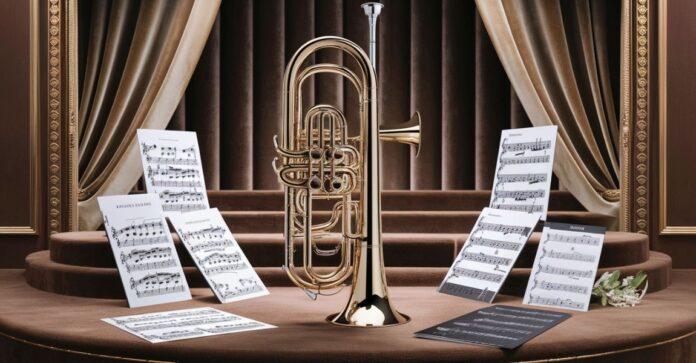What is a Flugelhorn?
The flugelhorn is a brass instrument that shares similarities with both the trumpet and the tuba. It produces a warm, mellow sound that is often described as a blend of these two instruments. Despite its name, the flugelhorn is not a member of the horn family.
History
The flugelhorn’s origins can be traced back to the 19th century. It evolved from the bugle, a military instrument. Early flugelhorns were used primarily in military bands. However, the instrument gained popularity in jazz and popular music during the mid-20th century.
Construction of a Flugelhorn
It is typically made of brass and has a similar shape to a trumpet. However, it is larger and has a wider bore, resulting in a lower pitch. The instrument has three valves that control the pitch of the notes.
Sound
The flugelhorn’s sound is rich, warm, and mellow. It has a wider range than a trumpet and can produce both bright and dark tones. This versatility makes it suitable for a variety of musical genres.
Flugelhorn in Music
The flugelhorn has found its place in various musical styles:
- Jazz: It is a popular choice in jazz music, offering a softer and more lyrical sound compared to the trumpet.
- Classical Music: While not as common as the trumpet in classical music, the flugelhorn can be used in orchestral pieces and chamber ensembles.
- Popular Music: It has been featured in popular music, including rock, pop, and funk. Its versatility allows it to blend well with different musical styles.
Famous Flugelhorn Players
Several renowned musicians have mastered the flugelhorns and contributed to its popularity:
- Miles Davis: This legendary jazz trumpeter also played the flugelhorn with great artistry.
- Chuck Mangione: Known for his smooth jazz style, Mangione is a prominent flugelhorns player.
- Kenny G: While primarily a soprano saxophone player, Kenny G has also showcased his flugelhorns skills.
Playing the Flugelhorn
Learning to play the flugelhorns requires dedication and practice. It is essential to develop good embouchure (lip position) and breath control. As with any brass instrument, proper technique is crucial to achieving a good sound.
Care and Maintenance
To keep your flugelhorns in optimal condition, follow these tips:
- Cleaning: Regularly clean the instrument with a soft cloth and mild cleaning solution.
- Valves: Keep the valves clean and oiled to ensure smooth operation.
- Storage: Store the flugelhorn in a case to protect it from damage.
- Professional Maintenance: Schedule regular check-ups with a qualified instrument repair technician.
FAQs
Q: Is the flugelhorn the same as a trumpet?
A: No, while they are similar in appearance, it has a larger bore and produces a lower, warmer sound than a trumpet.
Q: Can I switch between trumpet and flugelhorn easily?
A: While it’s possible to switch between the two instruments, there are differences in embouchure and technique that require adjustment.
Q: What is the best way to learn to play the flugelhorn?
A: Taking lessons from a qualified instructor is the best way to learn the flugelhorn. They can provide guidance on proper technique and help you develop your musical skills.
Q: Are there different sizes of flugelhorns?
A: Yes, It come in different sizes, with the most common being the Bb flugelhorns.
Conclusion
The flugelhorn is a captivating instrument that offers a unique blend of warmth and brilliance. Its versatility allows it to shine in various musical genres, from the soulful depths of jazz to the grandeur of classical music. While it shares similarities with the trumpet, it has its own distinct character that sets it apart.
Whether you’re a seasoned musician or a curious beginner, exploring the flugelhorn can be a rewarding musical journey. With proper care, practice, and dedication, you can unlock the full potential of this beautiful instrument and create music that resonates with audiences.



